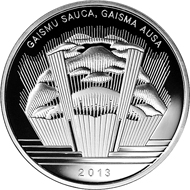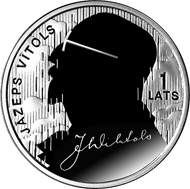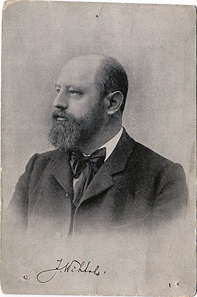September 12, 2013 – Marking Jazeps Vitols’ 150th anniversary, a collector coin with the motto “Gaismu sauca, gaisma ausa” (We called for light and there was light), has been issued therewith celebrating a composer who sang praise to the light and the founder of the professional musical education in Latvia. The coin has been designed by Arvids Priedite and modeled by Janis Strupulis. The coin was struck by Koninklijke Nederlandse Munt (the Netherlands).
Latvia / 1 lats / silver .925 / 22.0 g / 35.0 mm / Design: Arvids Priedite (graphic design) and Janis Strupulis (plaster model) / Mintage: 3,000.
The coin’s obverse shows Jazeps Vitols’ portrait in profile in the centre. The inscription JAZEPS VITOLS is semi-circled on the left, the digit 1 on top of the inscription LATS is on the right, and Jazeps Vitols facsimile signature is at the lower part of the obverse. The reverse’s lower part features five horizontal parallel lines, from which rays of light are spreading out like an arc, with a semi-circled inscription GAISMU SAUCA, GAISMA AUSA (We called for light and there was light) at the top, and the year 2013 at the bottom. The inscriptions LATVIJAS BANKA (Bank of Latvia) and LATVIJAS REPUBLIKA (Republic of Latvia), separated by rhombic dots, are written at the edge.
Jazeps Vitols. Source: Wikipedia.
Jazeps Vitols (1863-1948) had two working lives. Before the founding of an independent Latvian state, he was a highly respected professor at the St. Petersburg Conservatory, music critic, friend of Rimsky-Korsakov, Liadov and Glazunov as well as an activist of the Latvian community in St. Petersburg. When it seemed that the time was right to retire and enjoy fishing, a favorite pastime of Vitols, he returned to Latvia at the age of fifty-five and launched a new career: he established a conservatory, thereby laying the cornerstone for professional musical education in the young Latvian state. Up until his departure from Latvia in 1944, Vitols (with a brief hiatus) was head of the conservatory and raised a whole generation of brilliant musicians. With his gleaming pate, aquiline nose, favorably, but not excessively, inclined, invariably sporting a loose tie of white silk, he was always at the centre of the music life of the young country. The memories of Vitols pupils speak of great respect and love for their teacher.
Vitols was a patriarch of music education. He was also the author of witty, self-ironic memoirs, a knowledgeable (but not necessarily unprejudiced) reviewer of musical events, a good, if not very ambitious, conductor, an active public figure, and, last but not least, a composer. Over the years, he contributed several compositions of instrumental chamber music and piano pieces, some symphonic scores and, at the top of the list, his solo songs (still not fully recognized) and choir songs (recognized, yet seldom performed).
Albeit Vitols worked at a time when national romanticism was dominant, he was rather a representative of classicism. Balance, perfection of form, precision in laying out his thought are paramount in his music. Vitols does not attempt to draw his listener in. His “I” finds its expression in aristocratic reticence, which, nevertheless, is not devoid of passion, tragedy, love, or a good joke.
The Bank of Latvia now marks Professor Vitols’ 150th anniversary by issuing a collector coin with the motto “Gaismu sauca, gaisma ausa” (We called for light and there was light). And there is indeed much light in Vitols’ music, to mention only his choir songs Saules svetki (Celebration of Sun), Saule austrumos (Sun in the East), Diena aust (A New Day Dawning), Jau saule sarti kvelo sils (Woods Burnished Red by the Sun), Karalmeita (King’s Daughter) who is weaving new light, morning dawn in the song Pie dzintara juras (By the Amber Sea), etc. The paths of the light traced in his choir song Gaismas pils (Castle of Light) (1900) are, by all means, one of the most powerful symbols of the Latvian Song Festivals. It is always sung by the great joint mixed choir of the Festival and has been conducted by such masters as Jazeps Vitols himself, Teodors Kalnins, Leonids Vigners, Haralds Mednis and Imants Kokars. In a sense, Vitols’ music and his personality are also the nation’s castle of light that can never drown in oblivion.
For more information on this as well as other collector coins, please have a look at the Bank of Latvia’s website.
This is the website of the Jazeps Vitols Academy of Music.
And here you can listen to Vitols’ work ‘Gaismas pils’ on YouTube.







